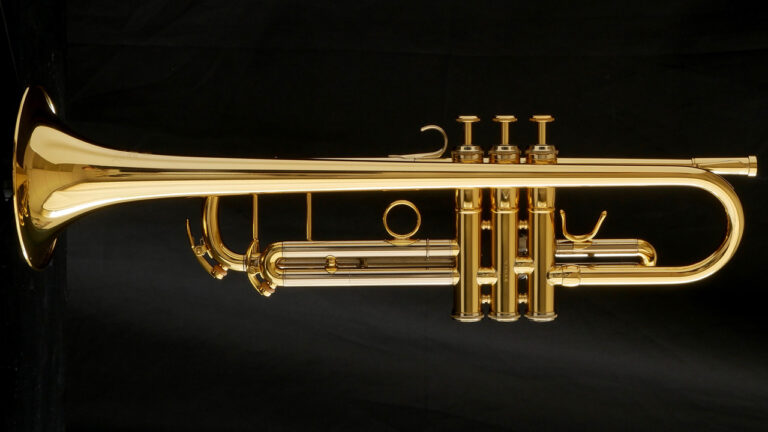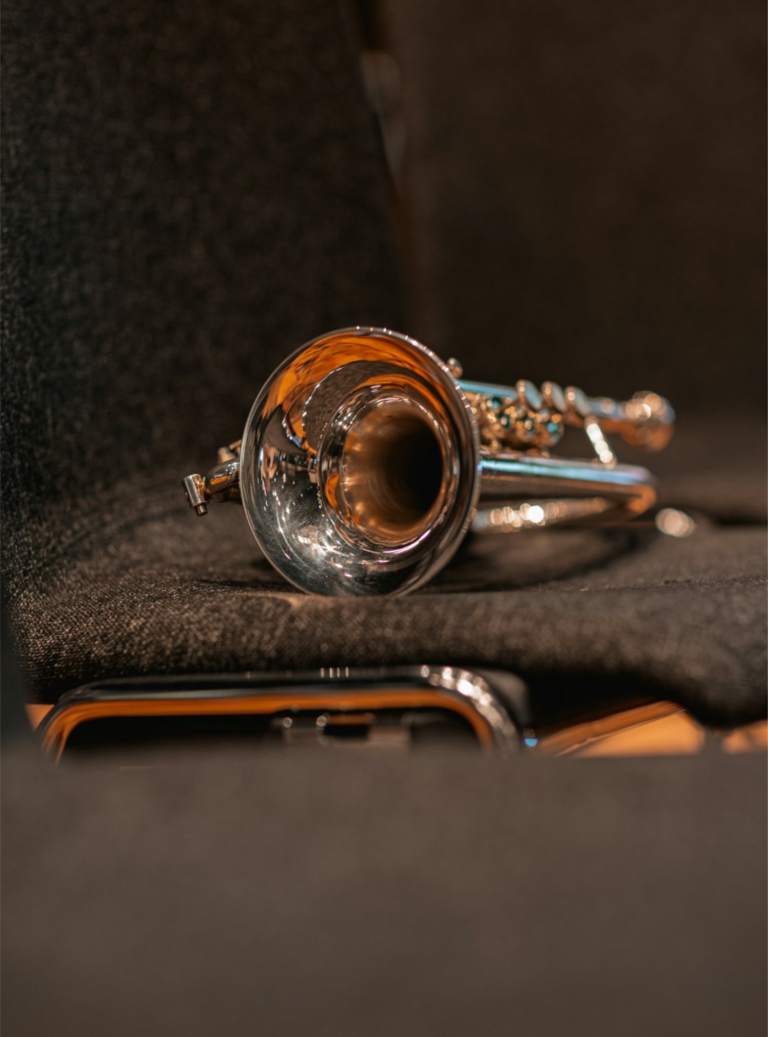More Air:
The air column is one of the most important elements for playing the trumpet (and other wind instruments) well. It is the foundation for sound production, dynamic control, timbre, and the instrument’s resistance. When you make good use of the air column, you gain more control and expressiveness while playing. Below is a detailed explanation of the importance of this concept:
What is the Air Column?
The air column is essentially the continuous flow of air that you generate when exhaling while playing. In the trumpet, this airflow is directed into the mouthpiece, which causes the lips, or the vibration of the mouthpiece reeds, to produce sound. This air flow needs to be constant, well-controlled, and of the right pressure for the sound to be clean and precise.
The Importance of Using the Air Column Properly:
- Sound Control and Tuning:
- Stable Pressure: To produce a clear and undistorted sound, it is essential that the air pressure remains stable. Irregular air flow can lead to imprecise or out-of-tune notes;
- Tuning: The control of the air column also directly affects tuning. If you do not control the air pressure and flow properly, the notes may sound either too high or too low. This is especially important for higher or lower notes, where air control is more demanding.
- Timbre and Sound Quality:
- When the air column is used correctly, the trumpet can produce a wide range of timbres, from a bright and powerful sound to a softer, more melodic tone. The air column directly affects the “color” of the sound, allowing you to explore different nuances;
- If the air column is not properly maintained, the sound may become “closed,” “gritty,” or weak. Proper air flow control enables the trumpet to sound full and resonant.
- Sustain and Endurance:
- The air column is essential for maintaining a sustained sound throughout a musical phrase. Good air support allows you to play long passages without needing to breathe frequently, which is crucial in complex pieces or continuous playing;
- Endurance on the trumpet is also directly related to air control. The better you manage air pressure, the more comfortable you will be playing across different dynamics and demands of the instrument, whether playing loudly or softly.
- Dynamic Control:
- The air column helps control the dynamics (volume) of the sound. To play softly, you need a gentler and more controlled airflow, while a louder sound requires a more intense and faster flow of air;
- This control is essential for expressiveness, as it allows for variations in intensity efficiently without compromising sound quality.
- Muscular Endurance and Posture:
- Playing the trumpet efficiently requires not only good air column control but also good coordination with the respiratory muscles (diaphragm, intercostals, and abdomen). A well-managed air column depends on the efficient use of these muscles;
- Additionally, posture is fundamental: good posture allows you to breathe correctly and manage air pressure better. Poor posture can hinder air flow and the endurance needed for playing.
- Precision of Notes and Articulation Control:
- The control of the air column also aids in the precision of articulations (the “cessuras” or breaks in sound made while playing) and in defining the clarity of notes. Constant airflow ensures that articulations are clear and without unwanted interruptions.
How to Improve the Use of the Air Column on the Trumpet?
- Breathing Exercises:
- Practicing specific exercises to control your breathing, such as diaphragmatic breathing (using the diaphragm to control airflow more efficiently), is essential. Deep and controlled breaths help strengthen the air column.
- Developing Muscular Endurance:
- Long and sustained exercises, such as playing long tones, help strengthen the respiratory muscles and maintain stable air pressure control.
- Control of Airflow:
- Practicing passages with varying dynamics (loud, soft, etc.) also helps develop better control of airflow. This can be done gradually, starting with softer dynamics and increasing intensity as endurance and control improve.
- Proper Posture:
- Work on maintaining proper posture while playing. Your posture should be relaxed and upright, which facilitates air control. Avoid tensing the neck, shoulders, or face, as this can block airflow and affect sound quality.
Conclusion
The air column is the foundation upon which all other trumpet skills are built. When well-controlled, it not only improves sound quality but also enhances endurance, dynamic control, and tuning. With a good air column, a trumpet player can perform more complex passages, explore a greater variety of timbres, and sustain long-term performance without compromising sound quality. Focused practice on controlling airflow is essential to reach the trumpet’s maximum potential.
Less Pressure:
Playing the trumpet without exerting excessive pressure is a fundamental concept closely related to the production of a healthy sound, the efficiency of the embouchure, the longevity of the musician, and the development of solid technique. Excessive pressure while playing the trumpet can compromise sound quality, hinder technique, and cause discomfort or even injuries. Below is a detailed explanation of the importance of playing the trumpet without exerting pressure:
What Does “Playing Without Pressure” Mean?
When we refer to “playing without pressure” on the trumpet, we are talking about the absence of excessive force in the embouchure, lips, and mouth when producing sound. This includes how you use the facial muscles (such as the lips, cheeks, and jaw) and how you control air pressure. The idea is to produce sound efficiently, without overstraining or tensing these muscles, which could result in poor sound quality, fatigue, or even injuries.
The Importance of Avoiding Excessive Pressure:
- Improved Sound Quality:
- Clear and Clean Sound**: When you play without pressing too hard on the mouthpiece, the vibration of the lips becomes more efficient. A tense embouchure with excessive pressure can hinder this natural vibration, resulting in a harsh, muffled, or distorted sound. Without excessive pressure, lip vibration is more fluid, and the sound tends to be clearer and more balanced;
- Rich Timbre**: Proper control of air flow, combined with a relaxed embouchure, allows the trumpet to produce a richer and fuller sound, with greater harmonic complexity. Excessive pressure tends to “close off” the sound, causing it to lose its tonal richness.
- Sustainability and Endurance:
- Reduced Muscular Fatigue**: When you play with the correct amount of pressure, you rely more on air flow control than on physical effort in the facial muscles. This enables you to sustain sound for longer periods without experiencing fatigue, which is essential for long passages and intense performances. On the other hand, excessive pressure can lead to premature muscular fatigue in the lips, making it harder to maintain sound quality over extended periods;
- Increased Injury Resistance**: Using excessive pressure while playing the trumpet can lead to muscle tension and, over time, problems such as tendinitis, lip pain, and even more serious injuries. This occurs because excessive force on the lips or jaw creates unnecessary, imbalanced strain on these muscles.
- Tuning and Articulation Control:
- Precise Tuning Control**: When you play without pressing, you can adjust the embouchure more effectively to achieve precise tuning. Excessive pressure can interfere with lip articulation, which directly affects tuning. Pressure on the lips can make the notes unstable or difficult to control, especially in higher registers;
- Clear Articulation**: Articulation (the “breaks” between notes, such as breath marks between phrases) is more effective when you are not pressing the mouthpiece too forcefully against the lips. Excessive pressure can “push” the articulations, making them less clear and precise.
- Ease in the High Register:
- Less Effort in High Notes: When playing in the higher registers of the trumpet, musicians often feel the temptation to press more, as a way of “helping” to reach the higher notes. However, this approach is counterproductive. When you play with excessive pressure, the lips become tense and less flexible, making it harder to produce high and precise notes. Relaxing and avoiding pressure allows for greater lip flexibility, which facilitates the execution of high notes with more precision and control;
- Dynamic Control in the High Register**: Proper use of the air column (rather than pressure) also makes it easier to produce a greater range of dynamics in the high register. You can play more softly and with greater control, without forcing the embouchure.
- Efficiency in Sound Production:
- Efficient Use of the Air Column**: When you play without excessive pressure, you use the airflow more efficiently, without forcing the lips or jaw. This allows the air to pass more smoothly and efficiently, enabling you to maintain a more balanced sound without needing to force the embouchure. Air control is more important than pressing the mouthpiece against the lips because air is the true source of sound in the trumpet;
- Less Fatigue When Playing for Extended Periods**: When you avoid excessive pressure, the respiratory system and facial muscles work more harmoniously, allowing you to play for longer periods without feeling exhausted. With excessive pressure, the facial muscles can tire quickly, limiting your performance.
- Reduced Facial Tension and Improved Embouchure:
- Relaxation in the Embouchure**: One of the main advantages of not using excessive pressure is that you can maintain a relaxed and balanced embouchure. This means the force needed to play the trumpet is distributed efficiently, without causing excessive tension in the facial muscles. A relaxed embouchure allows for more flexibility in the lips, helping to achieve a freer and more expressive sound;
- Embouchure Adjustment**: When you press too hard, the facial muscles can become tense and rigid, making it difficult to adjust the embouchure effectively. Without excessive pressure, you can adjust the position of your lips more easily, helping to improve control and expressiveness of the sound.
How to Avoid Excessive Pressure?
- Proper Posture: Maintaining good posture while playing the trumpet is crucial. Your posture should be relaxed, with your shoulders low and free from tension. When you keep your body relaxed, it becomes easier to avoid excessive pressure on the lips and jaw.
- Adequate Breathing: Deep and controlled breathing, utilizing the diaphragm, is essential to avoid pressure. When you rely on airflow rather than pressing with the lips, you can play more efficiently and with less effort.
- Embouchure Exercises: Practicing specific embouchure exercises, such as long tones, helps improve pressure control. Focus on relaxing the lips while maintaining a continuous sound without forcing it.
- Playing Relaxed: When practicing, always keep in mind that the goal is to play in a relaxed manner. Even during more difficult or fast passages, avoid the urge to press the mouthpiece too hard against the lips. Trust your technique and the efficient use of air.
- Listen to the Sound: Pay attention to the quality of the sound you are producing. If the sound feels forced or uncomfortable, you are likely using excessive pressure. Aim to achieve a clear and open sound without applying extra force.
Conclusion
Playing the trumpet without exerting excessive pressure is crucial for producing a high-quality, durable, and expressive sound. Excessive pressure can undermine tuning control, note articulation, endurance, and the health of the facial muscles. By relaxing the embouchure and focusing on efficient use of the air column, you can play more comfortably and with greater control, enhancing your performance and preventing injury. Developing the ability to play without pressure is one of the key aspects of becoming a technically proficient and healthy trumpet player over the long term.


